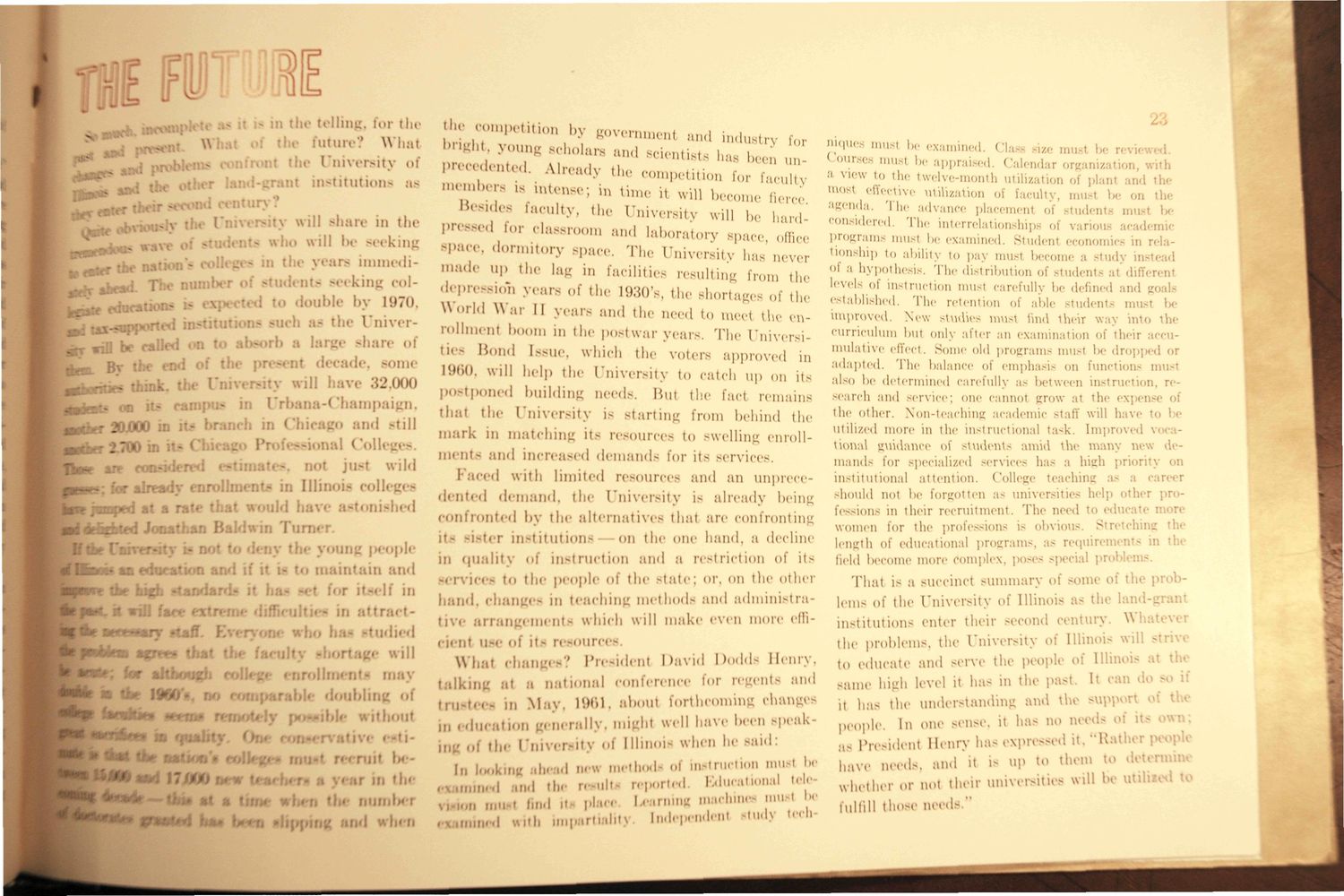| |
| |
Caption: Book - The Land Grant Tradition (1961)
This is a reduced-resolution page image for fast online browsing.

EXTRACTED TEXT FROM PAGE:
fpfl . «f* \\ . ad j - the telling, for the tl tutu What | t ilii I n i v e r - i t v of t *titutions ns \\ ill sh in the ill 1 ic tin- \ irs inn di• -'~ seeking col- h as the Univershare i ade, some ill I 2,000 l'r i, ' ' ' ml still I Col lege? va n ::.e i fho i «iU be called n gv The I oo cam; 20JO0O in "00 in : f**r tit - wild J.. ire*:" *rinilbu' Ms in Illinois colleges J at a ra" d n I T ;: •iiii_ le n and !ac> r. «* 'JOgb coUf-/< Ifr DO :- mi in and r itself in in tid ill in -lit -t j doubling b •Hi**) • •W 17HQri I ;#|i n tl nun 1 when ; '1 ' ' *y government and industry for 8Ch lar8 and 8 * * * *T« ° ^ t i s t s has b S un 9 nt€d Alread ™f '. y the competition for faculty me be ,8 ^ " " ' — to time i, will become fierce ,;i,Mlhv ****** - "'<• University will be hanL pre88ed for classroom and laboratory space ,.tr.ee Bpace, dormitory space. The University has never made U the P ^ g '». facilities resulting from the depression years of the 1930's, the shortages of the World War II years and the need to meel the enrollment boom m the postwar years. The Universities Bond Issue, which the voters approved in I960, will help the University to catch up on its postponed building needs. But the fact remains that the University is starting from behind the mark in matching it- resources to swelling enrollment- and increased demands for it- services. Paced with limited resources and an unprecedented demand, the University is already being onfronted by the alternatives that are confrontini it m r institutions — on the one hand, a decline in quality instruction and a restriction of its [*ervi - to tl people of the state; or, on the other md ( i in teaching methods and administrat e arrangements which will make even more •Hint ii it- resources. What chai ' President David I )<»\<\- Henrj t a national conference for cnts and ; n M; l V . 1961, about forthcoming chang< in education generally, might well h a w been speakj n j ,j the I'm raity oi Illinois when he Baid: |„ |oo| ing ,| ,,. method ol instruction must b „„, mil result* reported Educational teli „ urn • find iti plac< 1 rning machine, must ,th „„ Jit) Independent itudy tech ,H , ,,,niu ,,,,,,n m, w i 11 ' , must be examined. Cla size mu " musl be appraised. Calendar a view to the twelve-month util tion oi plant mos1 effective utilization of faculty, musl be ( agenda. ' !"• advance placement of students m idered. The interrelationships of varii programs must be examined. Student economi. in relationship i(, ability to pay must become a study h oi a hypothesis. The distribution of student* at differ levels of instruction musl carefully be denned and g stablished. The retention of able student* mi improved. New studies must find their way into the curriculum but only after an examination of their :umulative effect. Some old programs must be dropped or adapted. The balance of emphasis on functions musl also be determined carefully as betv n instruction, research and service; one cannol grow at the exp the oilier. Non-teaching a demic staff will have t« utilized more in the instructional task. Improved v •.tional guidance of students amid the many m mands for specialized services has i high priority on institutional attention. College teaching as a car should not be forgotten as universities help other professions in their recruitment. The need women for the professions is obvious. hing thi length of educational programs, as requii nts in field become more complex, ; ial | That is a succinct summary of som< the pr lems of the University of Illinois as the lan< institutions enter their second i itui Wl r the problems, the University Illin ill ,,, educate and serve the peoplt of Illin same high level it has in the | it. It n d it has the understanding and tl sup] people. In one sensi il has no n a8 i 8 ident Henrj has expressed it, "Rather ] have needs, and it is up to them whether or not their universities ' i il" fulfill those n-1 dfi "
| |